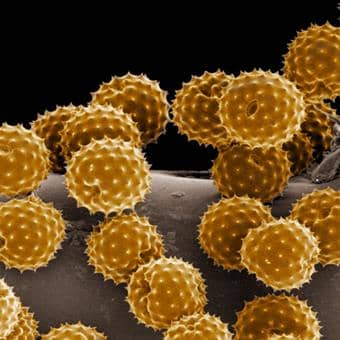What is different from pollen pollen

Already one thing that perg is considered as bee bread, sufficiently characterizes its importance for the life of a bee family.
The bee with the pollen, after passing the guard guard and entering the inter-frame space of the hive, unloads from its burden, shifting the collected dust particles to the wax cells or transferring the bees to the hive bees. Young bees, working near the storage premises of flower pollen, with their head shots, compact the pollen in the cells, while the other bees fill the upper layer of pollen with honey.
Impregnation with honey of the upper layer of pollen makes it inaccessible to air and thus protects it from spoilage. In pollen, closed on three sides with wax, and from above with honey, under the influence of enzymes of pollen and honey, important chemical changes (reactions) occur: some of the sugar is converted into lactic acid, which can conserve the perishable numerous components of pollen.
Thus, after a complex enzymatic process, pollen and honey are formed from the perga. This is a new product, as can be seen from the comparison of the chemical composition of pollen and pergium: 18% in pollen, 34.8% in peregium, 3.33 and 1.58% in fats, 24.06 and 21.74% in proteins %, mineral substances – 2.55 and 2.43%, lactic acid – 0.55 and 3.06%.
Even from these data it can be seen that between the pollen and the pearl (in terms of chemical composition and biological action), one can not equate. Meanwhile, not only beekeepers-practitioners, but also some scientists consider the words “pollen” and “pergh” to be synonymous. Unfortunately, such a definition can often be found in beekeeping literature, which describes the properties of flower pollen. In works carried out in France and England, it is not at all possible to establish whether it is pollen or perge, since in French and English the word “Pollen”
Perga is an indispensable protein-vitamin food. This opinion is confirmed by numerous experiments, which were carried out at different times and in different Union republics. Here is one of the experiments: in the fall, 10 bee colonies were selected cellular frames with perga and put them to other 10 bee families by 2 frames per family. In the spring (in mid-April), the families with pergus had an average of 18,480 larvae, and the gross harvest of honey was 68.6 kg per family, in control bee colonies deprived of Perga, respectively, 245 larvae and 26.8 kg honey.
Experiments conducted at the Ukrainian experimental station of beekeeping showed that bee colonies, who received additional top dressing from a mixture of honey and pergia, fed on average 42,560 larvae and produced 1239 g of wax, while control families, respectively, 19,467 larvae and 355 g wax. A year later, bee colonies, with their layers, who received a honey-pervasive mixture, fed 202,410 larvae and allocated 3.33 kg of wax, and control (without honey-pergardic fertilizing) during the same period-11,882 larvae and 0, 75 kg of wax.
It is proved that with the provision of bees, by the spring, the yield of honey and wax sharply increases. The annual requirement of the bee family in the perge is quite large, given that more than 100 mg of perga is spent on the rearing of one larva. In order to preserve the framework with perga, it is necessary to keep strong families, store these frames in dry ventilated rooms, and most importantly, to monitor the sanitary contents of the apiary and ancillary premises.
What is different from pollen pollen
